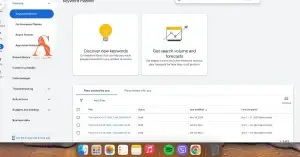
Keyword research tools in the world of digital marketing are the bread and butter of your brand’s online presence. That is why they are known as key phrases—these are the exact fragments of text that a potential client uses to find a particular service or product. For your website to top the search engine and draw organic traffic that enhances your business, developing a good keyword strategy is essential.
This week, the keyword research tool makes a much-needed debut. The tool for keyword research that I find most effective is Google’s keyword research tool. Actually, it is a free resource, which helps define the keywords relevant to the website, define the approximate number of queries per month, as well as the potential bidding strategy.
How to Use Keyword research tool for YouTube
- Access the tool: Go to your Google Ads account and log in. In order to continue, one needs to go to the “Tools & Settings” tab. Select “Keyword Planner.”
- Discover New Keywords: Type in a main keyword or key phrase that concerns your enterprise or goods.
- If you enter keywords, the keyword research tool will display more keywords and phrases associated with the typed keywords.
- Estimate Search Volume: The information that the keyword research tool offers is the average number of individuals who use keywords within one month.
- By using this information, you can identify which keywords are searched most frequently and which keywords are popular.
- Identify Keyword Difficulty: Keyword Planner does not have a metric such as keyword difficulty, but using site analytics programs like SEMrush or Ahrefs, you can estimate competition.
- Analyze Keyword Trends: The KW research tool requires geolocation and a date to be set before it shows historical trends of certain keywords for the period requested.
Guidelines for the Use of Keyword Planner as Keyword Research Tool for YouTube
- Long-Tail Keywords: By opting for more detailed keywords that are largely targeted and not as popular among the competitors, the narrow focus keywords should also be used.
- Keyword Relevance: Make sure the keywords you select meet or reflect the aim of your target market’s search.
- Keyword Grouping: It is recommended to divide those keywords into topical groups so that the content could be optimized properly.
- Keyword Density: Unfortunately, there is always the temptation to stuff keywords as much as possible into your content.
- Local SEO Keywords: Start utilizing state, city, or regional keywords if you are determined to focus on a particular area.
Beyond Keyword Planner: Other Effective Tools
While Keyword Planner is a valuable tool, there are other effective tools to complement your keyword research efforts:
- Google Trends: It is suitable to analyze time trends to understand which topics come as novelties and which keywords are more frequently used during certain seasons.
- SEMrush provides a full range of SEO tools, from keyword research to competitor analysis and backlink analysis.
- Ahrefs: Able to give good keyword studies, backlinks checks, and webpage prognosis.
- Moz Keyword Explorer: Provides true keyword difficulty results and has data of old search volume for certain terms.
Conclusion
This way, keyword research is used to its full potential for YouTube, and organic traffic is boosted by keyword research tools, among other tools. What you have to remember is that the keyword strategy is a cornerstone of effective SEO efforts. In order to see how keywords can assist you in creating an online presence, start your research with them now.
Read more